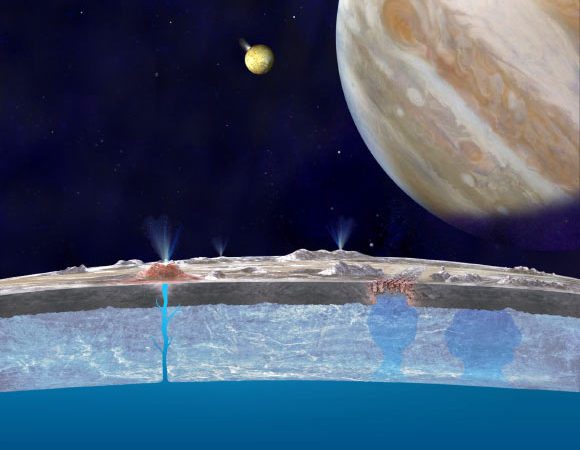A duo of U.S. planetary scientists has calculated that water in the subsurface ocean of Jupiter’s icy moon Europa could have been formed by breakdown of water-containing minerals due to either tidal forces or radioactive decay.
Source: Sci News
Dr. Mohit Melwani Daswani and Dr. Steven Vance from NASA’s Jet Propulsion Laboratory modeled geochemical reservoirs within the interior of Europa using data from NASA’s Galileo mission.
“We were able to model the composition and physical properties of the core, silicate layer, and ocean,” Dr. Melwani Daswani said.
“We find that different minerals lose water and volatiles at different depths and temperatures.”
“We added up these volatiles that are estimated to have been lost from the interior, and found that they are consistent with the current ocean’s predicted mass, meaning that they are probably present in the ocean.”
The researchers found that ocean worlds such as Europa can be formed by metamorphism: in other words, heating and increased pressure caused by early radioactive decay or later subsurface tidal movement would cause the breakdown of water-containing minerals and the release of the trapped water.
They also found that this ocean would originally have been mildly acidic, with high concentrations of carbon dioxide, calcium and sulfate.
“Indeed it was thought that this ocean could still be rather sulfuric, but our simulations, coupled with data from the NASA/ESA Hubble Space Telescope, showing chloride on Europa’s surface, suggests that the water most likely became chloride rich,” Dr. Melwani Daswani said.
“In other words, its composition became more like oceans on Earth. We believe that this ocean could be quite habitable for life.”
“Our models lead us to think that the oceans in other moons, such as Europa’s neighbor Ganymede, and Saturn’s moon Titan, may also have formed by similar processes.”
“We still need to understand several points though, such as how fluids migrate through Europa’s rocky interior.”
The authors presented their results today at the 2020 Goldschmidt Geochemistry Conference.
Source: Sci News

































Leave a Comment
You must be logged in to post a comment.